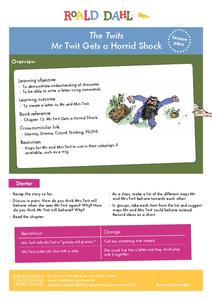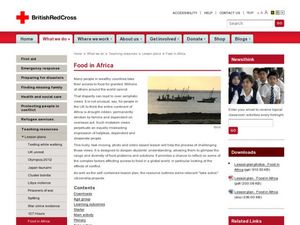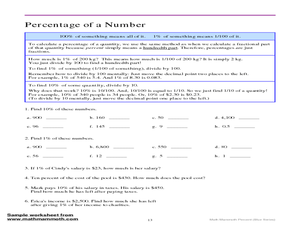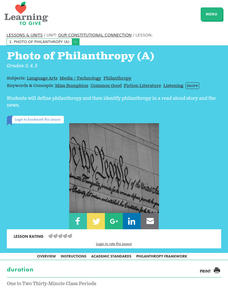Curated OER
Charity throughout History
Ever stop to think about why charities exist and when they started? Take a second to look through history and discover that giving has been apart of human society since ancient Rome. Jump to the US to uncover facts about our first...
Curated OER
Helping the Hungry: Researching the Causes of Hunger and Related Charities.
Students research the issue of hunger and poverty in the US. The class then works together to choose a charitable organization and develop a fundraising strategy.
Curated OER
Tzedakah Begins at Home (Private-Religious)
Students learn about the eight levels of tzedakah or charitable giving. In this philanthropy instructional activity, students examine the eight levels of charitable giving that were developed by Rabbi Moses Maimonides. They participate...
Curated OER
Opening our hearts and hands to others
Students study the act of charity in Judaism. For this charity lesson plan, students read about the act of giving in the Jewish culture called tzedakah, and give gifts to others.
Curated OER
Kids Collect LEGOs for New Orleans
Students read and discuss a news article about children that collected 1.5 million LEGO bricks for kids in New Orleans after Hurricane Katrina. They complete a fill-in-the blank activity, answer article comprehension questions, solve...
Curated OER
Creative Can Sculptures Help Feed the Hungry
Students look at pictures of Canstruction sculptures, then read a news article about the construction of these canned food sculptures. In this current events lesson, the teacher introduces the article with pictures of winning sculptures...
Curated OER
Giving Back
Students research the start of the March of Dimes and discuss the benefits of their actions when contributing to a charity. Students continue the lesson by calculating how much money would have been collected in a week, month, and year...
Curated OER
And It's All for Charity
Students fight poverty. In this current events lesson, students research the listed Web sites to find out how Red Nose Day was established by Comic Relief to raise funds to fight world poverty.
California Department of Education
Gaining by Giving
Community service is a win-win! Scholars discover how to gain valuable career skills through helping others using a lesson about volunteer work. Second in a six-part career and college readiness series, the activities focus on...
Curated OER
Penny Jar
Students collect pennies to donate to charity and calculate the number of pennies. In this penny counting lesson, students group pennies in tens and count how many dollars and cents they have. Students read a book about money. Students...
Curated OER
Street People
Students research homelessness including how people end up living on the streets and other related issues such as government response and charity. Using their research, students engage in improvisation, role-plays and monologues on the...
Curated OER
What Can They Do?
In this language arts worksheet, students answer 10 questions either with "No, they can't!" or "Yes, they can!" Example: "Can crocodiles climb trees? No, they can't!" Students then look at 5 picture clues and write something the person...
Roald Dahl
Matilda - The First Miracle
As the story unfolds, readers discover Matilda has a superpower. Take part in an activity that has learners talking about what superpower they would have, how they would use it, and how it could help others. Then, after reading the 14th...
Roald Dahl
Matilda - Throwing the Hammer
Full truth, or an exaggeration? How can you tell when a storyteller is exaggerating a story? Readers analyze a story told by Hortensia, and identify the exaggerative language she uses. Then, learners write their own narrative story using...
Roald Dahl
The Twits - Mr Twit Gets a Horrid Shock
Mr. and Mrs. Twit do not treat each other very nicely. The sixth lesson in an 11-part unit designed to accompany The Twits by Roald Dahl explores the way the characters talk to and treat one another. Role play and writing activities...
Curated OER
Today We Will Learn About Prefixes: non- not
Nonverbal, nonfat, nonfiction. The prefix non- (meaning not) is the focus of this affixes presentation that concludes with a check for understanding.
Curated OER
Donut Day
In this Donut day learning exercise, students complete activities such as reading a passage, phrase matching, fill in the blanks, choose the correct word, multiple choice, spelling, sequencing, scrambled sentences, asking questions,...
Curated OER
Business Christmas Cards Do's and Don'ts
In this grammar worksheet, students write the correct or negative imperatives in forty sentences depending on whether they think they are things they should or should not do.
Curated OER
Makes Cents to Me: Penny Drive
St that people have wants and must find ways to get them. In this philanthropy lesson, students understand the ways people get things and arrange a penny drive to help others. Students arrange an artistic project to reflect on their fund...
Curated OER
Food in Africa
Students examine the shortage of food in Africa. In this geography skills lesson, students consider how conflict and extreme situations may result in food shortages for some nations. Students analyze the provided photographs and videos...
Curated OER
Percentage of a Number
In this percentages practice activity, learners read an instructional section regarding percents and then solve 16 problems where they must find a given percent of a specific number. Students also solve 4 percent word problems.
Curated OER
Exercise on the Phrasal Verbs of "to turn"
In this vocabulary skills worksheet, students respond to 12 fill in the blank questions regarding the use of the phrasal verb "to turn". Students also write 4 original sentences using the phrasal verb.
Curated OER
A Photo of Philanthropy
Students identify a key idea in literature that is reflected in every day life. They define philanthropy. They recognize philanthropic deeds within self and others. They identify nonprofit organizations as important parts of the giving...
Curated OER
Find Somebody Who... 2-- Icebreaker Game
In this icebreaker game, students get to know their classmates by finding people who fit each of the 30 descriptions on the page and writing their names in the blanks.

























